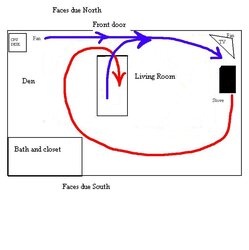OK... just got through my first season with my new Woodstock Soapstone Keystone wood stove. To be quite honest, for the 45,000 BTU output, I am quite dissappointed. However, I am 99% sure it has nothing to do with the stove...
We consistently had surface temps between 400-450 all year long. I was burning red oak with a 20-25% moisture content (used 4 prong moisture meter to test). My house was built in 1975, and all windows are original double pane Anderson casements and sliders. I have 12' cathedral ceilings in the great room that the stove is located in. For a better visual, I have attached a sketch of the floor plan of the first floor of my house.
This is the first floor of my split-level... 1,000 SF per level. We have a fully finished basement, but we chose to put the stove on the upper level, because we enjoy looking at the fire almost as much as we enjoy the warmth. However, after this season, we are strongly thinking about moving it downstairs. We have a family room down there, but it does not get as much use as the Great Room upstairs. I should also mention that the stairway to the lower level is completely open, and we keep the thermostat at 55 degrees when we're not down there.
As for the windows, I could feel a draft from the slider and the bay window. I sealed them as best I could, but the cold was still radiating through the panes. Also, we live 800 ft above sea level, and the constant winter wind has to be 15-30 MPH almost consistently. On days where there is no wind, the room temp jumps by 8-10 degrees. We have installed two 52 inch ceiling fans in the Great Room (remember, 12' ceilings), but it seems like all they do is bring up the cold air from downstairs. We have R-13 insulation in all walls.
I have thought of my options: close of the downstairs, replace the slider and windows, re-insulate the ceiling as best I can to R-35-40 (it's R-20 now), or move the stove to the lower level and cut registers in the floor. Although I can't quite center the chimney, I can get it closer to the center of the house on an outside wall.
I would GREATLY appreciate and and all feedback on my situation. I know this stove is capable of heating the whole house, but I just don't know what my next move should be. As with everyone, finances are tight, so I need an economical but long-lasting fix. THANK YOU
We consistently had surface temps between 400-450 all year long. I was burning red oak with a 20-25% moisture content (used 4 prong moisture meter to test). My house was built in 1975, and all windows are original double pane Anderson casements and sliders. I have 12' cathedral ceilings in the great room that the stove is located in. For a better visual, I have attached a sketch of the floor plan of the first floor of my house.
This is the first floor of my split-level... 1,000 SF per level. We have a fully finished basement, but we chose to put the stove on the upper level, because we enjoy looking at the fire almost as much as we enjoy the warmth. However, after this season, we are strongly thinking about moving it downstairs. We have a family room down there, but it does not get as much use as the Great Room upstairs. I should also mention that the stairway to the lower level is completely open, and we keep the thermostat at 55 degrees when we're not down there.
As for the windows, I could feel a draft from the slider and the bay window. I sealed them as best I could, but the cold was still radiating through the panes. Also, we live 800 ft above sea level, and the constant winter wind has to be 15-30 MPH almost consistently. On days where there is no wind, the room temp jumps by 8-10 degrees. We have installed two 52 inch ceiling fans in the Great Room (remember, 12' ceilings), but it seems like all they do is bring up the cold air from downstairs. We have R-13 insulation in all walls.
I have thought of my options: close of the downstairs, replace the slider and windows, re-insulate the ceiling as best I can to R-35-40 (it's R-20 now), or move the stove to the lower level and cut registers in the floor. Although I can't quite center the chimney, I can get it closer to the center of the house on an outside wall.
I would GREATLY appreciate and and all feedback on my situation. I know this stove is capable of heating the whole house, but I just don't know what my next move should be. As with everyone, finances are tight, so I need an economical but long-lasting fix. THANK YOU



